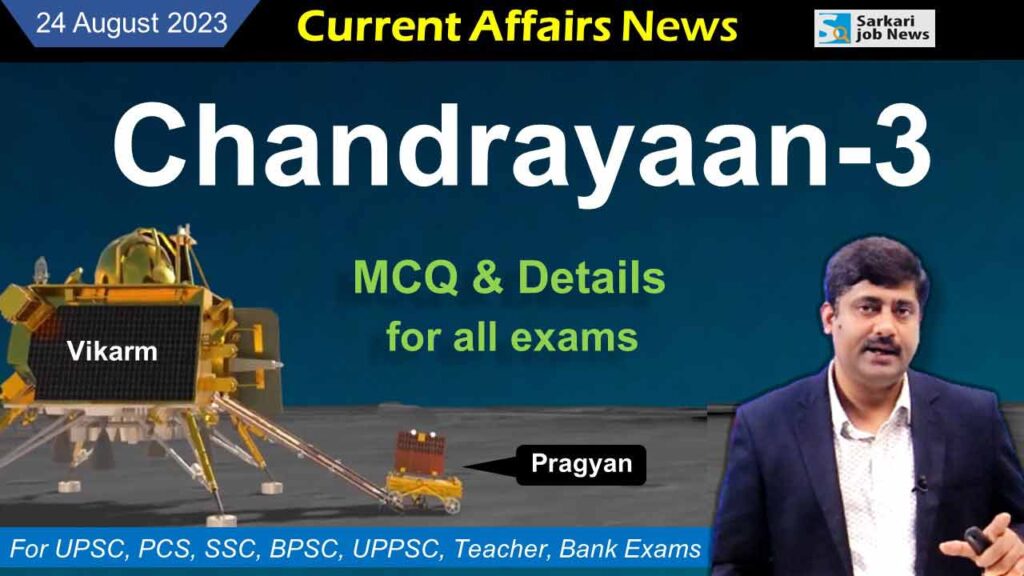This is the current affairs of 24 August 2023. It contains important questions and answers of Chandrayaan-3, which will help a lot in better preparation for government jobs.
PDF Download: Click here
1. In which part of the Moon did the soft landing of Chandrayaan-3 take place?
a. North Pole
b. South pole
c. Lunar Meridian
d. None of these
Answer: b. South pole

– Chandrayaan-3 created history by landing on the Moon’s South Pole at 6:04 pm on August 23.
—————
2. India has become which country in the world to successfully land a spacecraft on the moon?
a. First
b. Second
c. Third
d. Fourth
Answer: d. Fourth
– India has become the fourth country to successfully soft-land a spacecraft on the Moon.
– Prior to this, Russia, China, and the United States had achieved soft landings on the moon.
—————
3. Which is the first country in the world to land a spacecraft on the south pole of the Moon?
a. India
b. USA
c. China
d. Russia
Answer: a. India

– India’s Chandrayaan-3 spacecraft made history on August 23, 2023, by successfully landing the Vikram lander on the southern pole of the Moon.
– All eyes from around the world were on Chandrayaan-3. With this success, India became the first country to land on the southern pole of the Moon.
– Furthermore, it became the fourth country to achieve a soft landing on the Moon.
– Prior to this, Russia, China, and the United States have accomplished soft landings on the Moon.
– However, all of their efforts were concentrated in the equatorial region.
– The Vikram lander has achieved a soft landing near the southern pole, a remarkable achievement for India.
Upon landing on the Moon, the lander sent a message:
– At 6:04 PM, the Chandrayaan-3 lander took its first step on the Moon. Upon reaching the lunar surface, the lander sent a message: “I have reached my destination.”
How was the velocity of the Vikram lander reduced?
– Slowing down the velocity of the Vikram lander before descending to the Moon’s surface was also a challenge.
– For this purpose, the Chandrayaan-3’s Vikram lander was placed in a 125*25-kilometer orbit. It was then put into a deorbit.
– Afterward, when it was directed towards the Moon’s surface, its velocity was more than 6000 kilometers per hour.
– Then, within just a few minutes of softly landing on the Moon’s surface, its velocity was significantly reduced.
– At a height of 50 meters, the velocity had been slowed down to around 8 kilometers per hour.
– This allowed the Vikram lander to successfully touch down.
Then the record would have gone to Russia.
– Before India, Russia was the one to attempt a landing near the southern pole of the Moon with the Luna-25 spacecraft. This landing was scheduled for August 21st, but during a change in its final orbit, it veered off course and crashed onto the Moon’s surface.
—————–
4. What is the name of the lander of Chandrayaan-3?
a. Pragyan
b. Vikram
c. Chandra
d. Devadatta
Answer: b. Vikram

– After the soft landing of Chandrayaan-3 on the Moon, the lander was named Vikram.
– Vikram is named after Vikram Sarabhai, the father of space technology in India.
—————
5. What is the name of the rover of Chandrayaan-3?
a. Pragyan
b. Vikram
c. Chandra
d. Devadatta
Answer: a. Pragyan

– Earlier, Lander and Rover were not officially called by any name.
– After landing on the moon, ISRO officially named the lander as Vikram and the rover as Pragyan.
– This was also the name of Chandrayaan-2’s lander and Vikram, which crashed in the year 2019.
This time the orbiter was not sent in Chandrayaan
– Orbiter has not been sent this time in Chandrayaan-3.
This time an indigenous propulsion module has been sent in its place.
– It will take the lander and rover to the Moon’s orbit.
After this, it will continue to revolve around the Moon in a circular orbit of 100 km.
– It is not called an orbiter because it will not study the moon.
—————
6. Name the project director of Chandrayaan-3?
a. Mohana Kumar
b. P Veeramuthuvel
c. Ritu Karidhal
d. Rajendra Kumar
Answer: b. P Veeramuthuvel

– P Veeramuthuvel joined ISRO in the year 2014.
– After the failure of the Chandrayaan-2 mission in September 2019, he was appointed as the Project Director for the Chandrayaan-3 mission.
– Originally from Villupuram, Tamil Nadu, Veeramuthuvel father was a railway employee.
– On July 14, the Project Director P. Veeramuthuvel and the team of scientists remained continuously in the mission control center after the launch of Chandrayaan-3 from the LMV3 rocket.
– This same team also managed the task of controlling the speed of Chandrayaan-3.
– However, during the final 17 minutes of the spacecraft’s descent to the Moon, they simply kept a watchful eye. This is because the spacecraft’s soft landing was accomplished through automatic means.
—————
7. Name the Associate Project Director of Chandrayaan-3?
a. Rakesh Sharma
b. Ritu Karidhal
c. Kalpana Kalahasti
d. Rajendra Kumar
Answer: c. Kalpana Kalahasti

– Kalpana joined ISRO as a scientist in 2000 after studying B.Tech from Chennai.
– She is a resident of Chittoor district of Andhra Pradesh.
————-
8. Name the mission director of Chandrayaan-3?
a. M Srikanth
b. Ritu Verma
c. K Sivan
d. Rajendra Kumar
Answer: a. M Srikanth
Note – Mission Director for the launch of Chandrayaan-3 S. Mohana Kumar was However, after this, M. Srikanth played the role of Mission Director.
————-
9. Name the mission director for the launch of Chandrayaan-3?
a. Mohana Kumar
b. Ritu Verma
c. K Sivan
d. Rajendra Kumar
Answer: a. Mohana Kumar
Note – For the launch of Chandrayaan-3, Mission Director S. Mohana Kumar was However, after this, M. Srikanth played the role of Mission Director.
Scientist behind the success of Chandrayaan-3 mission
– Dr.S.Somnath (ISRO Chief)
– P. Veeramuthuvel (Project Director)
– M Srikanth (Mission Director)
– S. Mohana Kumar (Mission Director for the launch)
– Kalpana Kalahasti (Associate Project Director)
– V. Narayanan (Director of Liquid Propulsion Systems Center)
– M. Sankaran (Director of UR Rao Space Center)
– BN. Ramakrishna (ISTRAC Satellite, Navigation Director)
– S. Unnikrishnan Nair (Director of Vikram Sarabhai Space Center)
– Apart from these, there are other scientists who contributed a lot in this mission.
—————
10. With which rocket did ISRO launch Chandrayaan-3?
a. PSLV-M3
b. GSLV
c. LVM3-M4
d. SLV-3
Answer: c. LVM-3-M4 (Launch Vehicle Mark-3)

– Chandrayaan-3 was launched from the Satish Dhawan Space Centre in Sriharikota, Andhra Pradesh, on July 14, 2023, using the LVM3-M4 rocket.
– Its previous name was GSLV-III.
– This rocket is capable of launching 4,000-kilogram class satellites to Geosynchronous Transfer Orbit (GTO) and 8,000-kilogram payloads to Low Earth Orbit (LEO).
– It is a three-stage launch vehicle.
– It has two solid propellant boosters on its sides.
– The main components include the L110 liquid stage and the C25 cryogenic stage.
—————
11. Tell the cost of Chandrayaan-3 mission?
a. Rs 615 Crore
b. Rs 978 Crore
c. Rs 1000 Crore
d. Rs 2200 Crore
Answer: a. Rs 615 Crore
– On July 14, 2023, ISRO launched the spacecraft Chandrayaan-3 from the Satish Dhawan Space Centre located in Sriharikota, Andhra Pradesh.
– It landed on the southern pole of the Moon on August 23, 2023.
Why is the budget of Chandrayaan 3 lower than the previous mission?
– The cost of Chandrayaan-3 is reported to be 615 million rupees.
– In contrast, Chandrayaan-2 had cost 978 million rupees.
– Essentially, when Chandrayaan 2 was sent, it consisted of three components: the orbiter, lander, and rover.
– The orbiter remained successful and is still orbiting the Moon.
– So, this time, as we are sending Chandrayaan 3, we are not using an orbiter because the orbiter is already present there. Therefore, the total cost of our orbiter was saved this time.
– The best thing about ISRO is that they mostly do their work in-house. Meaning, they develop a lot of technology themselves, which allows us to implement major missions at a lower cost.
—————
12. For how long will Chandrayaan-3’s lander and rover remain active on the moon?
a. A lunar day (14 earth days)
b. Two lunar days (28 earth days)
c. Three lunar days (42 earth days)
d. Five lunar days (70 Earth days)
Answer: a. A lunar day (14 earth days)

– The lander will remain active on the Moon for one lunar day, which is equivalent to 14 days on Earth.
– For the Chandrayaan-3 lander to successfully land on the Moon’s surface, it’s essential for the Sun to be up at that location.
– Sunlight is necessary for the lander.
– On the Moon, the Sun rises for about 14-15 days and then there’s an equal period of about 14-15 days when the Sun doesn’t rise.
What is the objective of Chandrayaan-3?
– In this mission, a rover (a small robot) will be deployed from Chandrayaan, which will descend to the Moon’s surface and position itself at the lunar south pole.
– At this location, the rover will explore what minerals, water, atmosphere, and seismic activity can be found on this part of the Moon.
– This exploration will provide crucial insights, especially if we ever intend to establish colonies on the Moon in the future.
Total Weight
– Chandrayaan-3 consists of a lander, a rover, and a propulsion module. The total weight is approximately 3,900 kilograms.
The lander and rover are equipped with scientific instruments.
– The first one will measure the lunar seismicity (Moonquakes).
– The second one will determine how the Moon’s surface allows heat to flow inside.
– The third one will study the plasma environment.
– The fourth one will accurately measure the distance between the Earth and the Moon.
– The fifth one will search for minerals present in the soil.
What does identifying the plasma environment mean?
– ISRO’s Chief S. Somanath explains, “We know that there is no atmosphere on the Moon. But that’s not entirely true because gases do come out. Instead, they become ionized and remain very close to the surface. This changes with the day and night. On Chandrayaan-3’s lander, the Radio Anatomy of Moon-Bound Hypersensitive Ionosphere and Atmosphere (RAMBHA) instrument will measure the density of the near-surface plasma and its variations over time.”
Important Points
– When Chandrayaan-3 was launched: July 14, 2023
– Launch vehicle used: Launch Vehicle Mark-3 (LVM-3)
– Soft landing on the Moon: On the evening of August 23, 2023
– Landed at: The lunar south pole (Southern Hemisphere) for a soft landing
– ISRO (Indian Space Research Organisation)
– Chief: S. Somanath
Important Space-related Questions
1. First country to send a satellite into space: Soviet Union (Now divided into Russia)
2. First artificial satellite to reach space: Sputnik (October 4, 1957)
3. First living being to travel to space: Laika, the dog (Sent by the Soviet Union on November 3, 1957)
4. First human to travel to space: Yuri Gagarin (April 12, 1961)
5. First woman to travel to space: Valentina Tereshkova (Sent by the Soviet Union on June 16, 1963)
6. First Indian to travel to space: Rakesh Sharma (Reached space through a Soviet Union mission in April 1984)
7. First Indian-American woman in space: Kalpana Chawla
8. First spacecraft to orbit the Moon: Luna 10 (March 1966)
9. First country to send humans to the Moon: USA
10. First person to set foot on the Moon: Neil Armstrong (Landed on the Moon via the Apollo 11 spacecraft in 1969)
11. First country to send an unmanned mission to Mars: USA
12. First spacecraft to land on Mars: Viking-1

